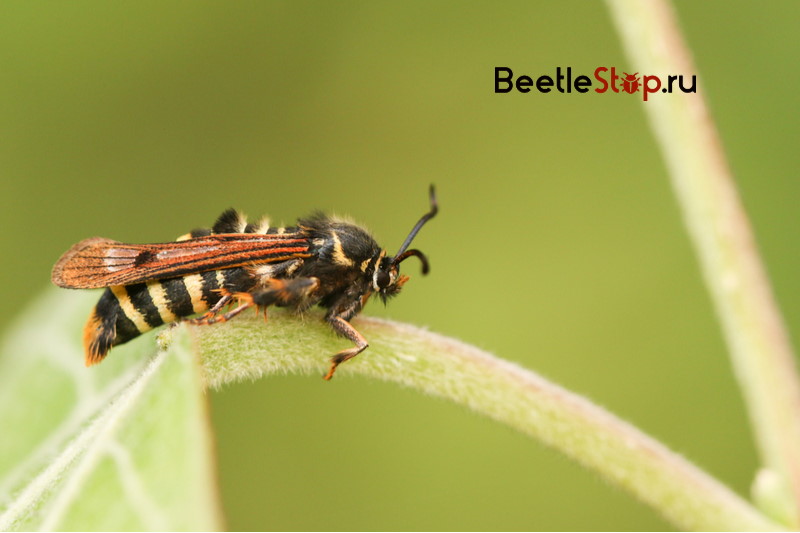Glassbasket - a dangerous pest of currants and raspberries

In the central zone of Russia, four types of glass-cases, the most typical of our gardens, deserve special attention. We will describe them in our review more closely.
Large poplar
As the name suggests, a large poplar glass-box parasitizes mainly on poplar. The butterfly has a wingspan of up to 45 millimeters and a black body with yellow stripes. Its caterpillars, and the number of eggs from one female reaches 1200, massively affects the fragile branches of poplars, which then break from a slight strong breeze, damaging other plants or buildings in the garden or utilities that have failed: electricity lines or telephone wires .
Apple tree
The apple-tree glass box has a peculiar appearance, with wings very narrow for butterflies, which, moreover, are small in scope and amount to only 22 millimeters. There is a red band on the dark body of the insect. Fertility of the female is 250 eggs.
By their standards, apple-tree glass is omnivorous, except for the apple tree itself, it also affects other fruit trees, such as:
- pear;
- quince;
- hawthorn;
- plum;
- cherry;
- Rowan;
- apricot;
- almond nut.
Currant
Currant glasshouse - a pest of red, white and black currants, as well as gooseberries. This small butterfly with a wingspan of only twenty millimeters is very similar to a wasp.
In particular, glass-box grows well on the currant of the old and neglected by the owners. The old branches of this shrub for this pest are a real food paradise and excellent incubation chambers.
Advice! Carry out regular sanitary pruning of fruit plants, timely remove old and atypically twisted shoots. Pay special attention to suddenly drying branches - this is a typical sign of damage to a glass-larva!
Raspberry
Raspberry glass is a quarantine pest of our favorite sweet berry, except for it it affects the next of kin - blackberries. The butterfly lays up to two hundred eggs on the soil near bushes and young shoots. Hatching larvae bite into the stems and gradually rise up inside them.
Inside the stems, these caterpillars then hibernate, which leads to the idea of how to deal with glass-boxes on raspberries. When planting repairing varieties on the plot with the complete cutting out of prolific shoots and their subsequent burning, we deprive the pest caterpillars of wintering places.
How to handle
Now that the enemy has been studied and identified by us, it's time to talk about how to deal with glass-boxes on blackcurrants, raspberries, apple trees and other fruit trees and shrubs. First of all, you need to study the prevention of infection of the site with these pests.
Prevention
In order not to use great efforts in the future to combat raspberries or other glass, you should keep your garden in order, avoiding a pile of dry and rotten branches, landfills and other places where the insects will be given a separate existence.
In this regard, the following activities should be regularly carried out on the site:
- sanitary pruning of dry, damaged and suspicious branches and shoots;
- on currants, anti-aging glassware is supplemented with anti-aging clipping of old branches;
- harvesting cut branches and stems off-site or burning them;
- pruning raspberries to zero at the end of the growing season;
- mulching plantings of raspberries will prevent butterflies from laying eggs on the soil;
- when planting, carefully inspect the purchased seedlings, especially if they were not taken from the nursery;
- elderberry glass pan scares well, therefore, it is desirable to have a couple of bushes of this plant on the site;
- vegetable and flower crops with a pungent odor scare glassware: tomatoes, garlic, nasturtium, marigolds, onions.
Remember! It’s better to prevent any trouble than to fight it heroically!
Fight
If nevertheless preventive measures did not help, or you ignored them, you will have to resort to hostilities. The most important measure against glass is pruning. if on raspberries it’s enough just to cut the bushes to zero, then they do differently with currants:
- We cut off the end of the suspicious branch and look at the cut.
- If the core is affected, cut below until the core is light.
- In the event that the lesion has become widespread, we cut out the plant completely in the hope that the root shoot will sprout and the bush will recover.
Insecticides, both biological and chemical, will also help. You can apply such aqueous solutions:
- “Fitoverm” - 2 grams per liter;
- "Lepidocide" - 2-3 grams;
- “Acarin” - 2 grams;
- “Bitoxibacillin” - 8-10 grams.
Advice! When treating plants with chemicals, remember to protect your skin and respiratory tract!
A very good raspberry glass video completes our report today:


 (votes: 18, average rating: 4,56 out of 5)
(votes: 18, average rating: 4,56 out of 5)